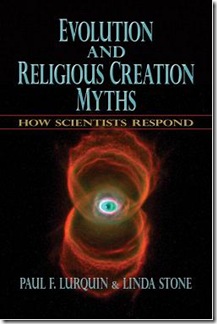Abstract for the book Evolution and Religious Creation Myths: How Scientists Respond by Paul F. Lurquin and Linda Stone
Intelligent Design thinking and older style creationism argue that evolution by natural selection is an incorrect theory. We demonstrate that, in doing so, neo-creationism (Intelligent Design, ID) and classical creationism misinterpret the meaning of scientific theories. This is because these religious doctrines imply teleology and purpose in the natural world, which are not analyzable scientifically. In addition, the concept of "irreducible complexity" often invoked by ID proponents is based on a flawed interpretation of scientific data. We also demonstrate that evolutionary thinking in the sciences is a powerful tool that can be used in the study of the origin of the universe, the origin of life and its diversification, and human evolution. Creationism and ID do not belong in the realm of science and have contributed nothing to its advancement. Further, attempts to force the teaching of creationism and ID in schools can only weaken a science curriculum which already leaves much to be desired.
Abstract for Chapter 1
We demonstrate that Intelligent Design can be called a form of neocreatonism that, just like old-style creationism, confuses the word "theory" with the words "postulate" and "fact." We also show that Intelligent Design implies purpose in the universe, a concept that science can neither support nor refute. We further describe creation myths as found in Buddhism, Hinduism, Islam and Judaism, and discuss how these myths influence scientific thinking in various societies.
Abstract for Chapter 2
This chapter describes the Darwin-Wallace theory of evolution by natural selection. In particular, we explain the notion of fitness, which underlies the concepts of descent with modification and the appearance of species categorized into clades. We show that descent with modification is a much better evolutionary theory than the "Great chain of being" model which implies that evolution is driven toward the production of more perfect and complex life-forms. Finally, we explain how the science of genetics strongly supports evolution through the notions of mutation, gene frequencies in populations, and drift.
Abstract for Chapter 3
Here, we rebut irreducible complexity and creationism by explaining the reliability of dating techniques as well as sophisticated laboratory techniques that allow researchers to synthesize extinct genes (genetic archaeology, gene resurrection) and study their homology to other genes. These techniques clearly demonstrate that the irreducible complexity of the eye, the immune system and the bacterial flagellum are subjective impressions. On the contrary, phylogenetic trees based on gene homology show a deep evolutionary link between simple life-forms and complex ones. Finally, we give several examples of "poor design" that cast doubt on the principle of Intelligent Design.
Abstract for Chapter 4
The notions of natural selection and drift also apply to humans and their biological and cultural evolution. The science of paleoanthropology explains human evolution through the study of intermediate fossil forms. In addition, geneticists have been able to retrace, through the study of mitochondrial DNA and Y-chromosome DNA, the origin and migrations of prehistoric humans.
The understanding of human cultural evolution has greatly benefited from the application of evolutionary thinking.
Abstract for Chapter 5
This chapter demonstrates that the origin of the universe was probabilistic, not preordained, because Heisenberg's uncertainty principle would have been violated at the level of the Big Bang. The appearance of structure in the universe was made possible by the decoupling of matter and radiation about 400,000 years after the Big Bang. Structure appeared--and continues to appear--without violating the second law of thermodynamics because entropy is not increasing as fast as it could, and this keeps the universe in a state of disequilibrium, not equilibrium. Life appeared as a consequence of this disequilibrium, possibly involving a sequence of events such as formation of an organic prebiotic soup (or synthesis of organic compounds in hydrothermal vents), the appearance of an RNA world, and the formation of lipid-bound hypercycles.
Abstract for Chapter 6
First life-forms appeared at least as early as 3.5 billion years ago in the form of prokaryotes. Some of these species developed oxygenic photosynthesis, which resulted in the presence of oxygen gas in the atmosphere. Later, eukaryotes appeared and diversified through mutation and gene duplication (including mutation and duplication of master genes), which led to the rewiring of entire gene networks. We show that there is no fundamental difference between macroevolution and microevolution. Finally, we show that making artificial life in the lab, as well as transgenic life-forms, would be impossible if the Intelligent Design scenario were correct. Indeed, ID posits that living systems were holistically designed and thus cannot be constructed in a piecemeal fashion.
Abstract for Chapter 7
Creationists and some conservative politicians are allies in a culture war that threatens science education in the United States. The threat comes from religious ideologies, such as Intelligent Design, that have never provided a shred of experimental evidence to buttress their claims. The proposition that evolutionary science is against human free will is baseless, and so is the contention that the theory of evolution deprives humans of purpose in life.
http://rapidshare.com/files/128151017/kitap37.rar (1742 KB, şifre: 37kitap7)




No comments:
Post a Comment